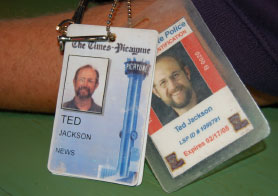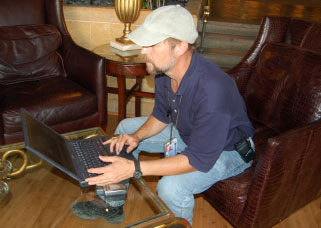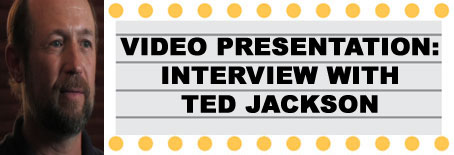 |
→ December 2005 Contents → Feature presentation |
The Ordeal of Ted Jackson
and the New Orleans Times Picayune |
|||||||
|
We first encountered Ted Jackson on October 1, one month after Hurricane Katrina devastated three Southern coastal states and Lake Pontchartrain drowned New Orleans. He and several other photographers, all Katrina veterans, had come to Austin to participate in a panel discussion as part of the 48th annual NPPA Flying Short Course hosted by The University of Texas Department of Journalism. Just as no one was prepared for what happened to New Orleans and the Gulf, those of us who attended the program that Saturday afternoon in Austin were ill prepared for what we would experience as well. We had all seen the news broadcasts and images in publications following Katrina, but as these photojournalists related their stories and showed us a profound body of work, we were gripped anew by a deeper realization of what had happened to our Gulf coast and the Crescent City.
"I have seen some weird shit, but this was something else," John Davenport told us, "worse than a war zone." Jake Neilson said he saw things he hopes he will never have to see again, adding, "Sometimes we see things that the military and other people don't want us to see." AP photographer Eric Gay said every single person he encountered had a story to tell, whether it was of the hurricane, the flood, the human tragedy or rescue, and that all were desperate to have their story told. Each photographer at the conference showed photographs we had seen and many we had not, and as we viewed their powerful and moving images, their own stories enhancing what we already knew of Katrina, the audience was soon dissolved into tears. When Davenport broke down, saying he had promised himself he would not, anyone who had not already been drawn into the emotional tide was finally brought into a group experience that was almost metaphysical. Thus primed, it was then that we heard from Ted Jackson.
Soft-spoken and mild-mannered, Jackson said he was guessing that NPPA wanted him to speak to us about what it was like to shoot the story of Katrina and New Orleans in one's own hometown. "You can 't believe this has happened to your own city," he began, and within moments, in his audience of around 100 students and professionals, you could have heard a pin drop as he related one of the most hypnotic and spellbinding stories we had ever heard from a photographer. And, of covering the devastation in his own city, he said, as if realizing it for the first time, "You're not covering a story, you're covering your life."
There were times when Jackson said he just couldn't shoot a picture, or was distressed about doing so, such as the morning after the worst of Katrina's fury had passed, but before the levees broke. Most of the staff, some with their families, had spent the night of the storm in the relative safety of the Picayune offices. When day broke, he went out in his truck to photograph the customary aftermath of what he thought was just another normal hurricane. Arriving on the bridge above St. Claude Avenue and discovering the road below flooding from the storm itself, Jackson found himself powerless to rescue several women and their children, trapped and clinging to the rails on their front porch. Partially submerged by the rushing, rising waters, they desperately beseeched him for help. There was no possible way to get to them across the road just 50 feet away without being swept away himself. Amid much anguish, he did shoot a few frames, but the images left in his mind for two months were perhaps more haunting than the photographs he did take. Realizing he could not deliver them from their peril, and understanding the power of hope, he called out to them to stay where they were, reassuring them that help would come.
When we visited Jackson in New Orleans, he took us to that house, now empty, ravaged, and dry. He told us he'd returned with a boat and a rope looking for the women and children, only to find them gone. Down the street, a man and his family were in the process of being rescued. Jackson told him he was glad he had gotten out, reminding him that he had been the one shooting photos as he saw him calling out from his attic window for help. But when asked, the man did not know what had happened to his neighbors. When we visited the scene on October 12, the fate of the women and children at 4702 St. Claude Avenue was still unknown. However, with the help of a writer in the Picayune's Living Department, Jackson has since discovered they were indeed rescued and evacuated to Houston, where they remain. Such was a happy resolution to one of many situations wrought by the disaster, but other times were even more difficult and without resolve. Jackson says after the levees broke the next day he found himself in circumstances where he put his camera down, being the only one on the scene. He decided that if he couldn't help them, he couldn't shoot their photo, and seems very clear about the times when he drew that line — when the best and most decent choice of a given moment was not to shoot.
Jackson is deceptively youthful-looking and moves with the upbeat agility of someone more likely the age of 25 than his 49 years. He has been a photographer for the New Orleans Times-Picayune covering city, state, national and international events for over two decades. In 1997, he was part of a team that won the Pulitzer Prize for public service for "Oceans of Trouble," a comprehensive look at the impending collapse of the world's fisheries. Other assignments include the Berlin Wall, Desert Storm in Iraq, multiple photo essays on Cuba, political upheavals in Haiti, earthquakes, hurricanes and now Katrina. Spending time with Jackson and hearing his stories, I got the idea his spirit has been animated by the same ageless and tireless passion the whole time. His son, 24-year-old Jeremy, maintains a blog (http://www.jeremiahlee.blogspot.com) and posted updates from the scant contact he was able to have with his dad and brother, Chris, a Coast Guard Helicopter Flight Mechanic doing rescue operations, during the first days of Katrina. As reported in Jeremy's blog, Jackson said it was time to come home (to his wife, Nancy, who had evacuated to Mississippi) "when the police started barricading themselves in to protect themselves from everyone else." He did join Nancy briefly out of harm's way on September 2, but he told us that for the 24 hours he was away from New Orleans, he was inextricably drawn to going back.
During our interview, Jackson described how the intensity and drama of the initial crisis and aftermath of Katrina have slowly given way to the reality of a forever-changed New Orleans, and we could see how the life of this story and the life of Ted Jackson have merged into one. The future of the Times-Picayune is still uncertain at this writing, but Jackson hopes the paper will survive and he will be there to cover the rebuilding of his city and the Gulf. His story is extraordinary; his interview on video, compelling. It is a tale of adventure and of an uncommon challenge to a photographer in his own hometown, who responded both as a human being and witness, heroically calling on his guts, wits, and wisdom as a life-transforming story unfolded. Most of all, I am impressed by the deeply spiritual lens through which Jackson remembers and communicates his ordeal. He has now shared that incredible story with The Digital Journalist, which we present to you in this issue. His son Jeremy's blogspot homepage contains a quote that fits Jackson and his experience perfectly, and I couldn't help but wonder if he wrote it: "True adventure exists when you don't know the outcome."
| |||||||


